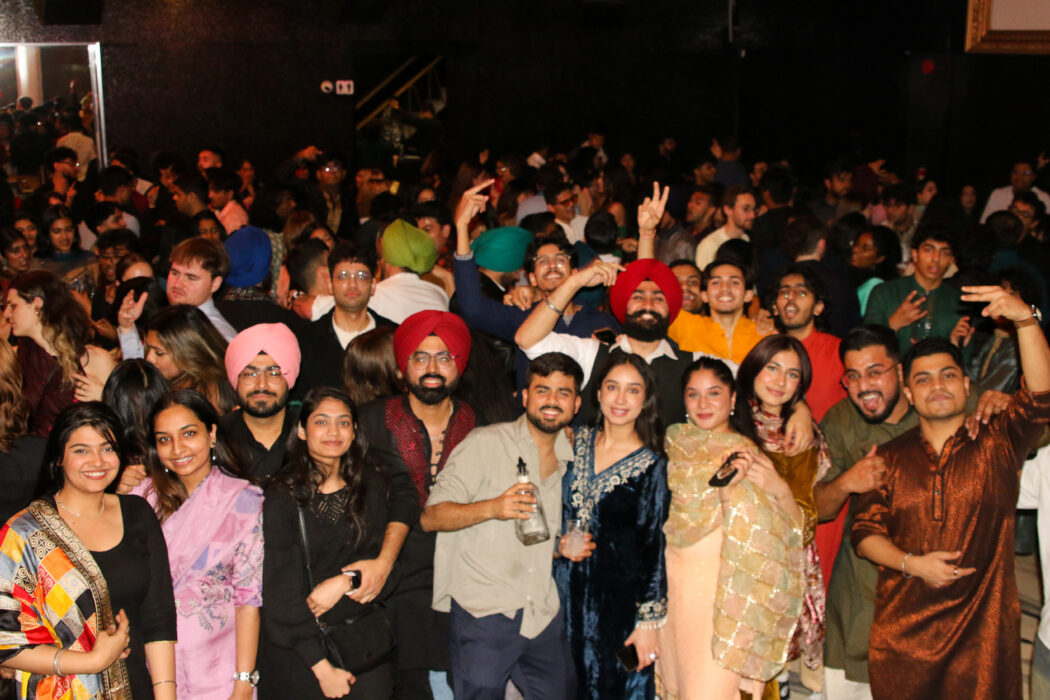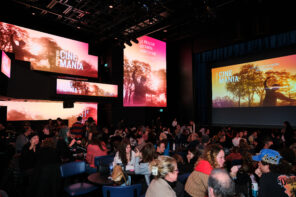Since 1963, McGill’s Indian Students’ Association (ISA) has been a cornerstone of cultural life on campus. But this academic year, its executive team was especially motivated to scale their impact, seeking to foster greater inclusivity within the club while reaching beyond the Roddick Gates to embrace Montreal’s wider South Asian community. As McGill’s second semester drew to a close, I sat down with ISA President Anushka Manoj, VP Finance Isha Sharma, and VP Equity & Diversity Anirudh Ram-Mohanram to reflect on their goals, the remarkable events they hosted—despite significant financial constraints—and the immense labour of love it took to bring them to life.
“It’s about building a viable third space,” Sharma explained, referring to ISA’s mission of creating an environment outside of work and home where a sense of cultural and social belonging can take root. “As immigrants, as international students, we often feel like we’re stuck in a rut—work, then home, work, then home—so it can be quite difficult for people to find their community.”
ISA has long offered South Asian students opportunities to connect through social events and cultural celebrations. But this year’s leadership wanted to deepen the club’s cultural programming. One of the ways they achieved this was through their partnership with the South Asian Studies Student Association (SASSA). Together, they co-hosted academic events, fostering important conversations around contemporary issues in South Asia. “My vision this year,” Manoj explained, “was to keep having all of those social events and also create a smaller, more comfortable space for the marginalized groups within the South Asian community.”
One of Manoj’s core goals was to ensure queer South Asian students felt genuinely welcome at ISA events. “I don’t think people in the South Asian community feel as comfortable coming out,” she said. “It’s just really hard to navigate that as a South Asian, even at a university like McGill.” This discomfort is something Manoj has experienced firsthand while moving through both academic and cultural environments. “As a South Asian queer person, I have felt uncomfortable stepping into South Asian spaces,” she shared, adding, “I’ve met so many South Asian queer people at McGill who haven’t felt comfortable going to ISA events in the past.” Sharma noted that “ISA has not been explicitly exclusionary to any group,” but agreed that visible, intentional outreach is essential when connecting with those who may feel othered in South Asian spaces. “I think it’s important to go out of your way and establish that—‘listen, you’re here and this is your space as well.’”
ISA’s revitalized commitment to inclusivity and community-building took shape through a series of ambitious events, beginning with a South Asian runway show. “The runway event was basically aimed at South Asian small businesses,” Sharma explained. “We really wanted to showcase Indian textiles, Indian artisans on a platform that really exposes these businesses and art styles to the young crowd of Montreal.” The event presented creative and logistical challenges unlike anything ISA had attempted before. “It was like scouting for small businesses, getting these people on board with us, trying to figure out how to be impactful for them, how we’re going to scale their businesses also,” Sharma highlighted. “Every single outfit that went into the runway was very logistically heavy but I’m really glad we accomplished it!” Manoj chimed in with admiration for her best friend: “I think it’s important to mention that the runway was completely Isha’s idea! It really helped us start the year off with a bang.” The show marked the advent of ISA’s outward-facing vision. “You partner with us, you showcase your textiles and your clothing and your designs on our platform, and we bring you business from our community,” Sharma explained. “It’s really about building that symbiotic relationship with people who aren’t ISA’s audience per se, but rather communities that haven’t really been involved with McGill.”
Remarkably, all of this unfolded under severe financial constraints. As they began planning their first event, they quickly realized they did not have enough money to pay for the venue. The moment was sobering—and almost derailed the runway altogether. “Everybody was really taken aback and there were questions about if we should even pursue the event in the first place.” But Sharma’s passion proved infectious, establishing “a gritty entrepreneurial spirit” early on that carried the executive team throughout the year, ultimately allowing them to exceed previous years’ revenue despite receiving less SSMU funding than ever before.
Following the runway show’s success, ISA turned its attention toward its flagship event and one of the most significant celebrations in the South Asian calendar: Diwali. “Diwali is a really big festival for us. It’s very profound,” Sharma emphasized. “For Indians to celebrate Diwali is very iconic and very memorable because we do it with our families every single year. So the one time of the year we really miss our families is during Diwali.” This emotional weight raised the stakes for ISA to deliver a meaningful experience. “For us, it was a lot of pressure to host this event, and match up to its scale, match up to its impact, match up to the fun that people have,” Sharma admitted. “You need a large amount of capital. It’s going to take money to give your community something grand and worthwhile.” However, as they had already demonstrated with the runway show, what ISA lacked in funding they made up for in tenacity. Despite budget constraints, they delivered a beautiful evening of food, festivities and, for many, a much-needed taste of home. As with the runway event, the executive team saw Diwali as an opportunity to get entrepreneurially-creative and connect with the wider South Asian community in Montreal. To this end, they collaborated with local Desi-owned restaurants, giving these small businesses campus exposure while managing their own catering expenses.
After pulling off two large-scale events on a limited budget, ISA’s executive team found their energy depleted. “There was a bit of momentum lost after Diwali because everyone was so exhausted,” Ram-Mohanram explained. “I do think that it’s a lot for students. And it’s been a gre by at learning process, but it’s also really stressful.” He believes that ISA’s initiatives succeeded this academic year in spite of institutional apathy, sharing, “I wish that sometimes there was more support to student clubs—particularly cultural and religious student clubs at McGill. I feel like we represent a large demographic at McGill but we don’t really have any of the funding of the networks of McGill.” This concern is exemplified by the personal risk Sharma took by renting the runway venue in her own name. “Completely from a personal perspective,” she shared, “the VP Finance is supposed to sign the contract. Any failure to pay the sum…whoever signs the contract takes the responsibility. So, for me as a student, it was huge.” “I think my point is,” Ram-Mohanram added, “that if we were given more support, then it wouldn’t be so up to the individual person’s will to get things done.”
Despite these personal and institutional challenges, the team found that strategic partnerships could offer both relief and renewal. One collaborative effort that reinvigorated the team after Diwali was “BDBollywood,” a Desi-themed night at Bar des Arts (BDA) that brought South Asian music to the popular campus venue. Ram-Mohanram got the idea after McGill’s Spanish & Latin American Students’ Association (SLASA) collaborated with BDA on a Bad Bunny theme night. Like ISA, BDA wants to foster greater inclusivity within their space. As Ram-Mohanram shared, “ the managers this year were so helpful and so sweet and so onboard with the idea. They see that BDA is a space for all.” The event represented strategic outreach beyond ISA’s typical audience. “For ISA, we know a lot of the Indian diaspora students and international students are going to come—and we also often get a lot of students from other South Asian countries—but outside of that, sometimes we have a very limited reach, which makes sense because we’re a culture club,” Ram-Mohanram explained. “BDA is very diverse. There are so many different groups of people that go there every week, so I feel like it’s really cool to do a pop-up at BDA.”
This collaborative spirit became the foundation for ISA’s most ambitious programming yet. While events like Holi and Diwali honoured cherished traditions, ISA’s final event of the academic year perhaps most fully embodied Manoj’s vision for what cultural clubs can be. Her personal passion project took the shape of a queer South Asian film festival that was not just a celebration of South Asian cinema, but a deliberate effort to create space for voices rarely centered in conversations about South Asian identity. The ambitious event showcased four Indian films that challenge mainstream narratives around both queerness and South Asian identity. “I started by reaching out to directors from India—smaller arthouse directors who have travelled through various film festivals and queer film festivals in India,” Manoj revealed. “One of them Isha actually connected me with because they’re from her city. And we’re both from smaller cities in India—like we’re not from Delhi or Mumbai—so most people don’t know the cities that we’re from.” The film festival celebrated a more nuanced representation of South Asian experiences. “The goal is really to showcase India, showcase the diaspora, and also just show that there are vibrant real communities in India beyond just the metropolitan cities,” Manoj shared. She noted that even when South Asian perspectives appear in mainstream media, they often reflect narrow viewpoints. “All representation isn’t good representation so, even when India is represented, it’s dedicated to privileged backgrounds and dedicated to the bigger cities normally represented in pop culture.” For Manoj, this curatorial work was deeply personal, transforming her relationship to her own community. “My city has such a vibrant queer community which I didn’t know about back home,” she told me. “That would have made life so much easier as a queer person in my city but I didn’t know about it.” Sharma saw the film festival as an evolution of ISA’s mission, sharing that “with ISA, for the longest time, we’ve shared our culture and brought people together but, at the same time, the impact has been limited. So when we talk about creating a loved third space, it’s not just about bringing people together to dance and party, but also having meaningful discussions about what it means to be South Asian in Montreal.” Through events that center overlooked identities within the South Asian community, ISA aimed to welcome students who might not have previously seen themselves reflected in the club’s programming.
The film festival embodied the kind of meaningful cultural work that makes ISA essential to campus life. Yet this success highlights a critical concern about sustainability. While ISA’s unwavering dedication to sharing and celebrating their culture with the McGill and Montreal community is admirable, the burden of operating under severe financial constraints raises an important question. It is one that Ram-Mohanram posed directly: “What happens one year if people aren’t as driven?” This concern carries particular weight in light of McGill’s recent decision to terminate its relationship with the Students’ Society of McGill University (SSMU), which funds over 250 clubs, student groups, and essential services. The decision—made after SSMU allowed a vote for students to strike in support of Palestinian liberation—exposes what Ram-Mohanram calls “a really bad flaw in the system,” adding that “so many different things on campus that make this university good and vibrant are so reliant on SSMU.” McGill’s power to essentially debilitate SSMU-funded clubs underscores the necessity for associations like ISA to extend their programming beyond campus boundaries. This year, ISA increased self-reliance by diversifying funding sources and collaborating with other student groups. “I hope that SASSA, ISA, and other South Asian clubs will continue to do more events together and collaborate,” Ram-Mohanram said. “With the pressures and burdens of all the stuff happening at the university with extracurriculars, it’s necessary for clubs to work together more to have these events.”
Despite constant financial concerns and the exhaustion of organizing multiple events, what ultimately sustained ISA’s executive team were the close friendships and loving community they built with each other. “From the moment we had our first meeting, everyone was so committed and so passionate to do this,” Manoj reflected. “Full credit to the exec team! Everyone has stayed so enthusiastic throughout the year.” This adoration was evident throughout my conversations with Manoj, Sharma, and Ram-Mohanram, who beamed when speaking about one another, their team, and the bonds that kept their ambitious dreams intact. For Manoj, the personal impact has been profound. As she explained, “When you move to an entirely different country—which is like 10,000 kilometres away—at the ripe age of eighteen, you wonder, ‘where do I fit in?’” The answer, she discovered, lies in community-building. “When you come here, you realize that if you don’t have a space that already caters to you, you have to create that space for yourself.” This academic year, ISA’s executive team has shown what is possible when passion meets purpose, crafting inclusive spaces where all South Asian identities can thrive. As uncertainty looms over McGill’s funding landscape, their resilience and collaboration offer a powerful model for cultural clubs facing similar challenges. What began as a mission to expand ISA’s reach has blossomed into a vibrant third space—one where South Asian students can celebrate both tradition and innovation. Through thoughtfully curated events and an unwavering sense of care, this dedicated team has built a home away from home. As Ram-Mohanram puts it, even in the face of obstacles, “I know that I can do it because I do it for the love of ISA”—a sentiment that perfectly captures the beating heart that continues to make this community thrive.








